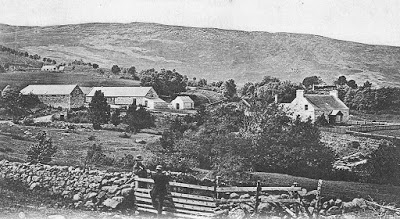Annotation:Balleterach Strathspey: Difference between revisions
No edit summary |
m (Text replacement - "<div style="text-align: justify; direction: ltr; margin-bottom: 90px; margin-left: 70px; margin-right: 120px;">" to " <div style="text-align: justify;">") |
||
| (2 intermediate revisions by the same user not shown) | |||
| Line 7: | Line 7: | ||
---- | ---- | ||
<div style="page-break-before:always"></div> | <div style="page-break-before:always"></div> | ||
<p><font face=" | <p><font face="sans-serif" size="3"> | ||
<div style="text-align: justify | <div style="text-align: justify;"> | ||
<br> | <br> | ||
'''BALLETERACH STRATHSPEY.''' Scottish, Strathspey (whole time). E Flat Major. Standard tuning (fiddle). AAB. Composed by Aberdeenshire fiddler-composer [[biography:Alexander Walker]] (b. 1819). Walker includes the note "Once the residence of Lord Byron." Ballaterach (Balleterach, Ballatric) a farm-house in Glenmuick parish, Aberdeenshire, near the south bank of the Dee, four miles east of Ballater. It was the residence of Lord Byron (1788-1824) when a boy. The steading caught on fire in 1868, a few years after Walker's collection was published, burning among other things a bed that was an attraction as it was thought to be the one the poet slept in. The a box-bed "reappeared" soon thereafter, and so the fiction was maintained for the poet's visiting admirers. | '''BALLETERACH STRATHSPEY.''' Scottish, Strathspey (whole time). E Flat Major. Standard tuning (fiddle). AAB. Composed by Aberdeenshire fiddler-composer [[biography:Alexander Walker]] (b. 1819). Walker includes the note "Once the residence of Lord Byron." Ballaterach (Balleterach, Ballatric) a farm-house in Glenmuick parish, Aberdeenshire, near the south bank of the Dee, four miles east of Ballater. It was the residence of Lord Byron (1788-1824) when a boy. The steading caught on fire in 1868, a few years after Walker's collection was published, burning among other things a bed that was an attraction as it was thought to be the one the poet slept in. The a box-bed "reappeared" soon thereafter, and so the fiction was maintained for the poet's visiting admirers. | ||
| Line 17: | Line 17: | ||
<div class="noprint"> | <div class="noprint"> | ||
== Additional notes == | == Additional notes == | ||
<p><font face=" | <p><font face="sans-serif" size="3"> | ||
<font color=red>''Source for notated version''</font>: - | <font color=red>''Source for notated version''</font>: - | ||
<br> | <br> | ||
<br> | <br> | ||
</font></p> | </font></p> | ||
<p><font face=" | <p><font face="sans-serif" size="3"> | ||
<font color=red>''Printed sources''</font> : - Walker ('''A Collection of Strathspeys, Reels, Marches &c.'''), 1866; p. 36. | <font color=red>''Printed sources''</font> : - Walker ('''A Collection of Strathspeys, Reels, Marches &c.'''), 1866; p. 36. | ||
<br> | <br> | ||
<br> | <br> | ||
</font></p> | </font></p> | ||
<p><font face=" | <p><font face="sans-serif" size="3"> | ||
<font color=red>''Recorded sources'': </font> <font color=teal> - </font> | <font color=red>''Recorded sources'': </font> <font color=teal> - </font> | ||
</font></p> | </font></p> | ||
Latest revision as of 17:03, 11 June 2019
X:1 % T:Balleterach Strathspey (Once the residence of Lord Byron) C:Alexander Walker M:C L:1/8 R:Strathspey B:Walker - Collection of Strathspeys, Reels, Marches etc. (1866, p. 36) Z:AK/Fiddler's Companion F:http://digital.nls.uk/special-collections-of-printed-music/archive/105875510?mode=zoom K:Eb B,|E>GF>G E<B,B,>C|E>GC>E F2 F>d|e>B c/d/e/c/ B<G E>G| C>F E/D/C/B,/ [G,2E2]-[B,E]:|E>BG>B E>BG>B|e>Bg>B d<ff>g| e>BG>B E>BG>B|C>F (E/D/)(C/B,/) (E2 E>)B|e>BG>B E>BG>B| E>Bg>B d<ff>g|b>ga>f g>ef>d|e>cB<a gee||
BALLETERACH STRATHSPEY. Scottish, Strathspey (whole time). E Flat Major. Standard tuning (fiddle). AAB. Composed by Aberdeenshire fiddler-composer biography:Alexander Walker (b. 1819). Walker includes the note "Once the residence of Lord Byron." Ballaterach (Balleterach, Ballatric) a farm-house in Glenmuick parish, Aberdeenshire, near the south bank of the Dee, four miles east of Ballater. It was the residence of Lord Byron (1788-1824) when a boy. The steading caught on fire in 1868, a few years after Walker's collection was published, burning among other things a bed that was an attraction as it was thought to be the one the poet slept in. The a box-bed "reappeared" soon thereafter, and so the fiction was maintained for the poet's visiting admirers.

